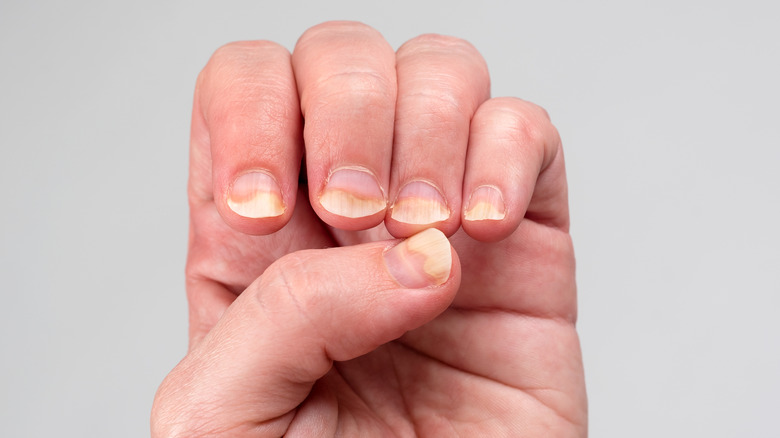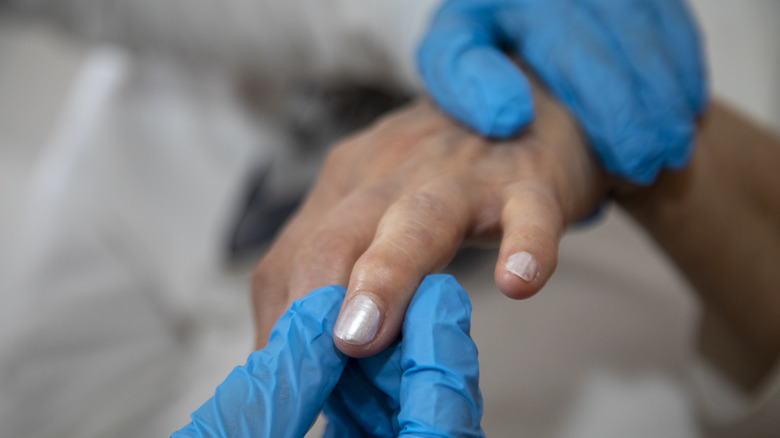If This Is Happening To Your Nails It May Be An Autoimmune Disease
According to the National Stem Cell Foundation, autoimmune diseases affect nearly 4% of the world's population. In the United States alone, approximately 23.5 million people have an autoimmune condition, of which 80% are women (via Johns Hopkins Medicine). According to the Cleveland Clinic, there are more than 100 autoimmune conditions, which include lupus, psoriasis, Crohn's disease, and rheumatoid arthritis.
According to Healthline, the immune system is designed to kill viruses, bacteria, or other foreign substances. However, when you have an autoimmune condition, your immune system mistakenly deploys fighter cells to attack your body, making you vulnerable to several health conditions. Some autoimmune diseases can affect various body parts, and the nails aren't an exception. If you notice changes in the color, shape, and texture of your nails, it may be the result of an autoimmune disease. It's important to consult with your doctor to understand the best way to manage the condition.
What autoimmune conditions affect the nails?
Nail psoriasis is an autoimmune condition that alters how your fingernails look (via WebMD). Often, the nails become unusually thick, change color or shape, or may develop pinprick holes, says WebMD. Apart from the changes in surface appearance, the nail can also loosen or separate from its bed. Furthermore, a chalky white material can build up under the nail and lift it away from the skin.
Rheumatoid arthritis is another autoimmune disease that can cause various changes in your nails, per Healthline. The condition can also cause vertical ridges on the nails or cause the nails to become unusually thick or discolored.
Nail issues can also occur in people with lupus, affecting about 25% of people with systemic lupus erythematosus, per a 2004 study published in the Journal of the European Academy of Dermatology and Venereology. Lupus is a lifelong autoimmune disorder that attacks various healthy cells, leading to tissue damage and inflammation (via WebMD). When it affects the nails, it can cause them to crack or fall off. The skin around the base of the nail can also swell, making it look red and puffy. According to the American Academy of Dermatology Association, lupus can also cause nail discoloration. The nails may become dark or blue-black, especially among people with discoid lupus and a darker skin tone.
Diagnosis and treatment for autoimmune-related nail conditions
According to a 2021 study review published in the Journal of Rheumatology, it might be difficult to differentiate the symptoms of nail psoriasis from other causes of nail problems. Furthermore, nail psoriasis can be hard to treat and treatment might take time to work, according to Healthline. Common nail psoriasis treatments include topical medications, oral drugs, corticosteroid injections, and various light and laser therapy options. According to a 2022 review published in StatPearls, topical therapy might be the best solution for mild nail psoriasis cases, affecting one or two nails with no significant symptoms. The American Academy of Dermatology Association adds that multiple treatments can be used since the condition can be hard to treat.
If your doctor confirms your nail changes are linked to rheumatoid arthritis, they might recommend a treatment plan to help manage the symptoms (per Healthline). Nail disorders caused by rheumatoid arthritis might be tricky to treat since the condition has no cure, per the National Health Service (NHS). It's crucial to seek early medical assistance since some of the symptoms of rheumatoid arthritis may worsen without treatment.
The same applies if you suspect your nail changes may be connected with lupus. According to Hospital for Special Surgery, diagnosing lupus is easy if you display some of the condition's classic signs. Without them, diagnosis may be delayed. Depending on your blood test results, your doctor may recommend nonsteroidal anti-inflammatory drugs, corticosteroids, antidepressants, and other options.


